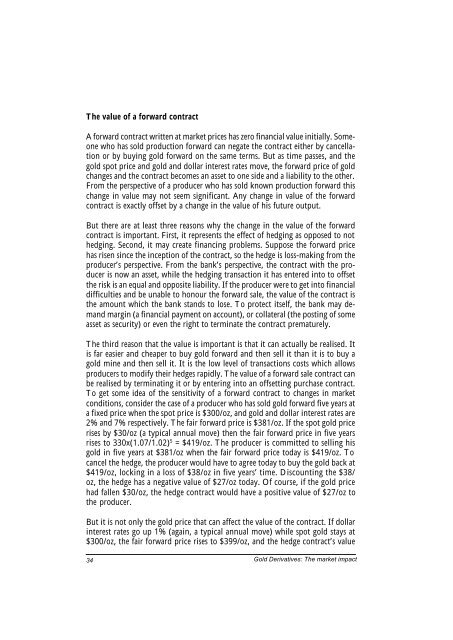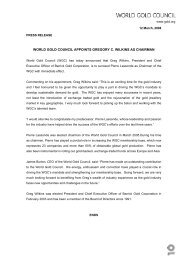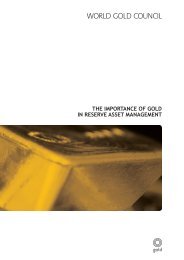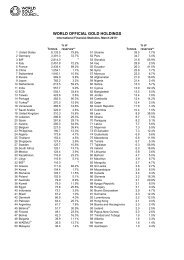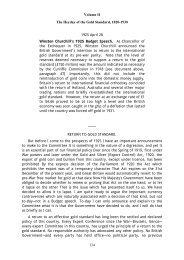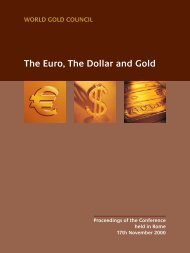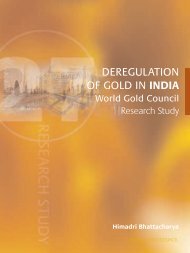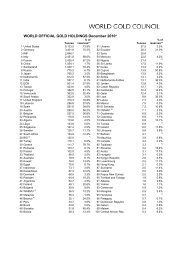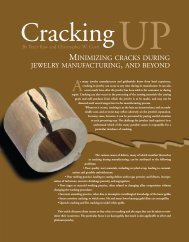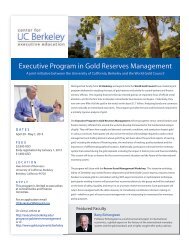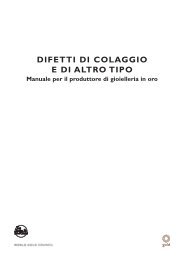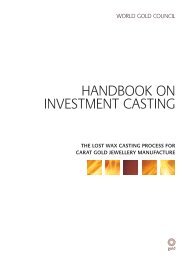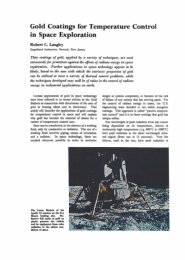Gold Derivatives: Gold Derivatives: - World Gold Council
Gold Derivatives: Gold Derivatives: - World Gold Council
Gold Derivatives: Gold Derivatives: - World Gold Council
Create successful ePaper yourself
Turn your PDF publications into a flip-book with our unique Google optimized e-Paper software.
The value of a forward contract<br />
A forward contract written at market prices has zero financial value initially. Someone<br />
who has sold production forward can negate the contract either by cancellation<br />
or by buying gold forward on the same terms. But as time passes, and the<br />
gold spot price and gold and dollar interest rates move, the forward price of gold<br />
changes and the contract becomes an asset to one side and a liability to the other.<br />
From the perspective of a producer who has sold known production forward this<br />
change in value may not seem significant. Any change in value of the forward<br />
contract is exactly offset by a change in the value of his future output.<br />
But there are at least three reasons why the change in the value of the forward<br />
contract is important. First, it represents the effect of hedging as opposed to not<br />
hedging. Second, it may create financing problems. Suppose the forward price<br />
has risen since the inception of the contract, so the hedge is loss-making from the<br />
producer’s perspective. From the bank’s perspective, the contract with the producer<br />
is now an asset, while the hedging transaction it has entered into to offset<br />
the risk is an equal and opposite liability. If the producer were to get into financial<br />
difficulties and be unable to honour the forward sale, the value of the contract is<br />
the amount which the bank stands to lose. To protect itself, the bank may demand<br />
margin (a financial payment on account), or collateral (the posting of some<br />
asset as security) or even the right to terminate the contract prematurely.<br />
The third reason that the value is important is that it can actually be realised. It<br />
is far easier and cheaper to buy gold forward and then sell it than it is to buy a<br />
gold mine and then sell it. It is the low level of transactions costs which allows<br />
producers to modify their hedges rapidly. The value of a forward sale contract can<br />
be realised by terminating it or by entering into an offsetting purchase contract.<br />
To get some idea of the sensitivity of a forward contract to changes in market<br />
conditions, consider the case of a producer who has sold gold forward five years at<br />
a fixed price when the spot price is $300/oz, and gold and dollar interest rates are<br />
2% and 7% respectively. The fair forward price is $381/oz. If the spot gold price<br />
rises by $30/oz (a typical annual move) then the fair forward price in five years<br />
rises to 330x(1.07/1.02) 5 = $419/oz. The producer is committed to selling his<br />
gold in five years at $381/oz when the fair forward price today is $419/oz. To<br />
cancel the hedge, the producer would have to agree today to buy the gold back at<br />
$419/oz, locking in a loss of $38/oz in five years’ time. Discounting the $38/<br />
oz, the hedge has a negative value of $27/oz today. Of course, if the gold price<br />
had fallen $30/oz, the hedge contract would have a positive value of $27/oz to<br />
the producer.<br />
But it is not only the gold price that can affect the value of the contract. If dollar<br />
interest rates go up 1% (again, a typical annual move) while spot gold stays at<br />
$300/oz, the fair forward price rises to $399/oz, and the hedge contract’s value<br />
34<br />
<strong>Gold</strong> <strong>Derivatives</strong>: The market impact


